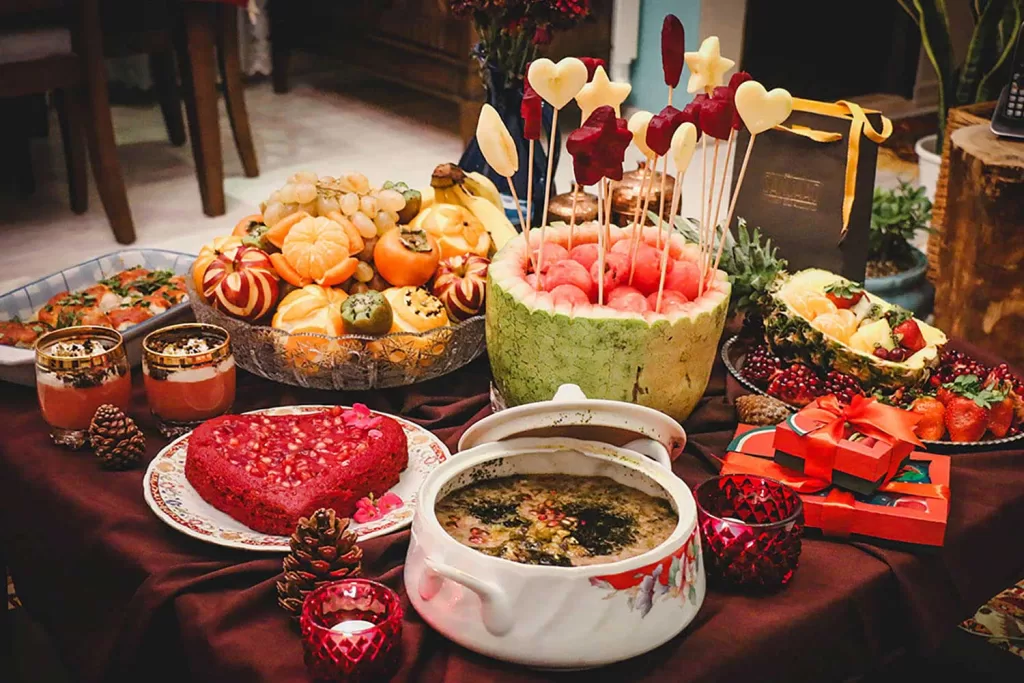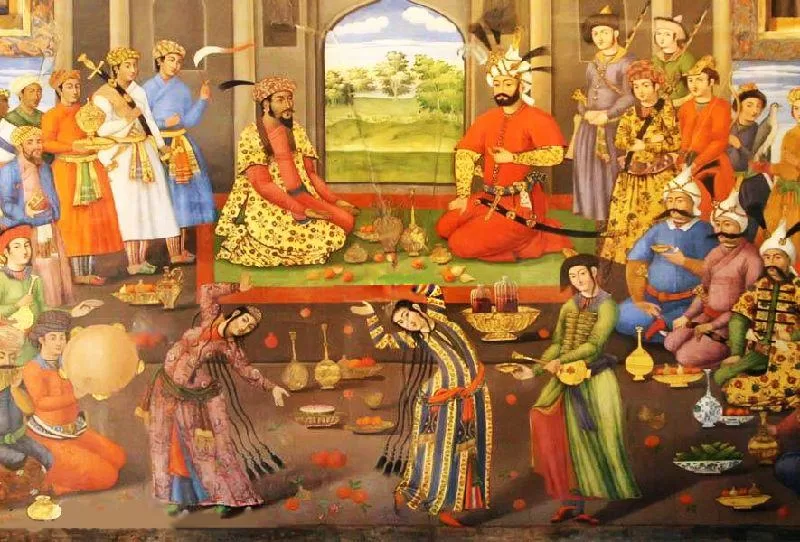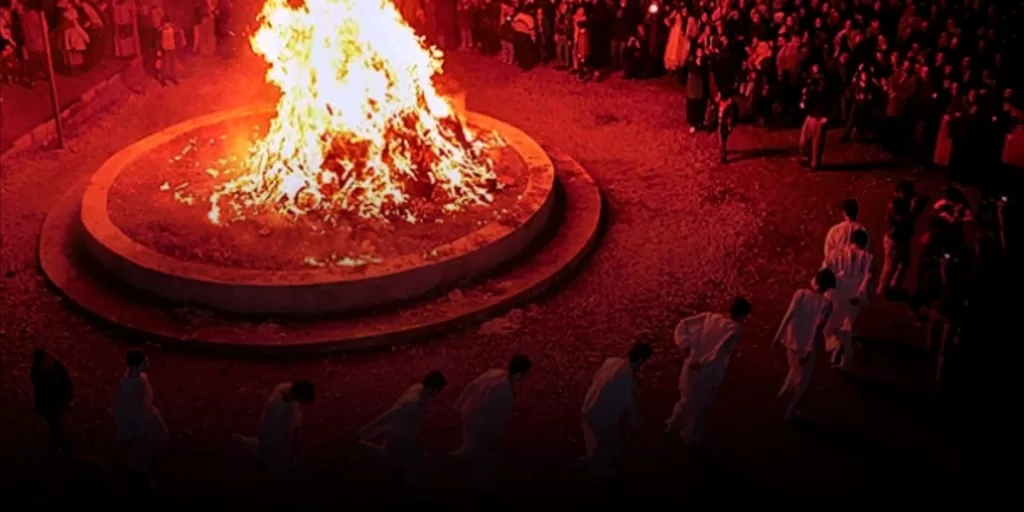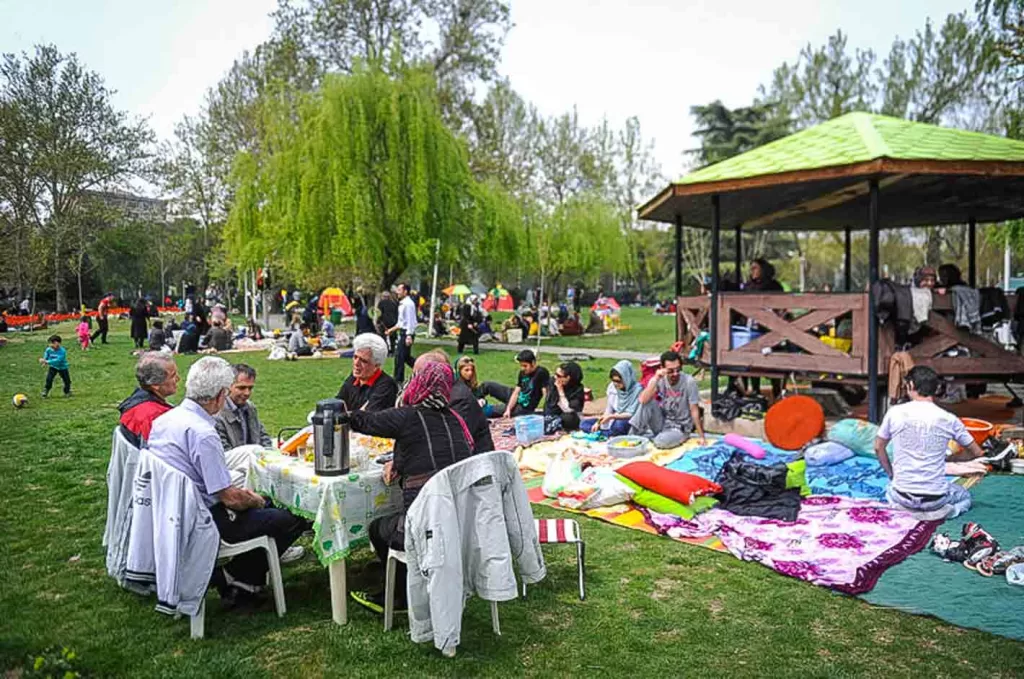Iranian Culture at Its Finest: Famous Persian Festivals Everyone Should Experience
Iran is a country renowned for its cultural heritage, and its festivals reflect this rich history. The traditional Iranian festivals have been celebrated for centuries and are an integral part of Iranian life. Let’s dive into some of the most famous Persian festivals.
Norouz: The Persian New Year

Norouz is the most significant festival in Iran, marking the beginning of spring and the Persian New Year. Families gather together, exchange gifts, and prepare elaborate feasts featuring traditional dishes like Sabzi Polo Mahi, a fragrant herb rice dish with fish. During Norouz, people also participate in cleaning their homes, which represents purification and renewal. Additionally, Haft-Seen, a table setting with seven items all beginning with the letter “S” in Persian, is prepared and placed in homes for good luck and prosperity. It’s a must-celebrate Persian festival!
Yalda Night: The Longest Night of the Year

Yalda Night celebrates the victory of light over darkness, marking the winter solstice, the longest night of the year. Families stay up late into the night, eating pomegranates, reading poetry, and sharing stories. Fruits with red and orange colors such as pomegranate and watermelon are symbols of the sunrise that brings hope and light to the world. It’s one of the oldest Iranian festivals and still very popular today.
Mehregan: The Persian Festival of Autumn

Mehregan is an autumn festival that celebrates the season’s bounty and beauty. It is a time for giving thanks and showing gratitude for nature’s gifts. People decorate their homes with flowers, prepare special meals, and visit friends and family. Traditional games like “Kolah Ghermezi” are played during this festival. It’s a beautiful way to welcome the fall season!
Chaharshanbe Suri: The Fire-Jumping Festival

Chaharshanbe Suri is held on the eve of the last Wednesday before Norouz. This festival is all about purification and releasing negative energy by jumping over fires while reciting traditional poems. Additionally, people buy fireworks and light them on this day. It’s a great opportunity to celebrate Persian culture!
Sizdah Bedar: The Thirteenth Day of Nowruz

Sizdah Bedar is the thirteenth day of Norouz, and it’s a day for spending time in nature and enjoying the outdoors. Families picnic in parks and countryside areas, and young unmarried people play pranks on each other, hoping to find love and happiness in the coming year. People usually eat “Sabzi Polo ba Mahi,” a dish made with herb rice and fish, during this picnic. Don’t miss out on this amazing experience!
Ashura: A Day of Remembrance and Mourning

Ashura is a day of mourning and remembrance for Shia Muslims, who commemorate the martyrdom of Imam Hussein, the grandson of Prophet Muhammad. During this day, people participate in processions, visit mosques, and serve food to mourners. In some cities, people perform a passion play called “Taziye” that depicts the events leading up to Imam Hussein’s death. It’s a significant event for the Muslim community.
Eid al-Fitr: The End of Ramadan
Eid al-Fitr marks the end of Ramadan, a month of fasting for Muslims. On this day, families gather together, exchange gifts, and enjoy feasts with traditional dishes like “Sheer Birinj,” a sweet milk rice pudding. Additionally, people often donate money to charity and visit friends and family. It’s a wonderful way to celebrate the end of a sacred month.
Eid al-Adha: The Feast of Sacrifice
Eid al-Adha honors the willingness of Prophet Ibrahim to sacrifice his son for God’s sake. During this festival, families sacrifice an animal and distribute the meat to the poor and needy. They also gather together for feasts with traditional dishes like “Kebab,” a grilled meat dish. It’s an essential celebration for the Muslim community.
Zoroastrian Festivals in Iran
Iran is home to Zoroastrianism, one of the world’s oldest religions. There are several Zoroastrian festivals celebrated throughout the year, including Sadeh, Jashne-e Tirgan, and Mehregan. These festivals celebrate nature, light, and the triumph of good over evil. It’s a unique cultural experience!
Religious and National Holidays in Iran
In addition to the festivals mentioned above, Iran has several religious and national holidays that are observed throughout the country. These include Islamic holidays like Eid al-Fitr, Eid al-Adha, and Ashura, as well as other holidays like Republic Day, Independence Day, and Martyrs’ Day.
Food and Drink Traditions during Iranian Festivals
Food plays an important role in Iranian festivals, and each celebration has its own unique dishes and flavors. During Norouz, people usually serve “Sabzi Polo Mahi” (herb rice with fish), “Reshteh Polo” (rice with noodles), and “Kuku Sabzi” (a type of omelet with herbs). On Yalda Night, people eat pomegranates, melons, and nuts. During Eid al-Fitr, people often make desserts like “Sheer Birinj” (sweet milk rice pudding) and “Zoolbia-Bamieh” (deep-fried dough soaked in syrup). Additionally, traditional drinks like “Doogh” (yogurt drink) and “Sharbat” (a sweet fruit syrup) are often served during these festivals.
Traditional Clothing and Decorations during Iranian Festivals
Iranian festivals are also characterized by traditional clothing and decorations. Women wear colorful skirts and scarves, while men don traditional jackets and hats. Homes are decorated with flowers, candles, and intricately woven carpets. During Norouz, people prepare “Haft-Seen,” a table setting with seven items all beginning with the letter “S” in Persian, including “sabzeh” (sprouted wheat), “samanu” (a sweet paste made from wheat germ), and “senjed” (dried lotus fruit).
Music and Dance Traditions during Iranian Festivals
Music and dance are integral parts of Iranian culture, and they play a vital role in many festivals. Traditional instruments like the ney flute, tar, and daf drum are often used, while traditional dances like the group dance “bandari” and the solo dance “raqs-e-sharqi” are performed during festivals.
Modern Celebrations and Festivals in Iran
Iran’s festivals and celebrations also have a modern side. The Tehran International Book Fair, the Fajr Film Festival, and the Shiraz International Poetry Festival are just a few examples of the country’s thriving contemporary arts scene. Additionally, events like the Tehran Marathon and the Iran International Auto Show attract people from all over the world.
Historical Background and Significance of Iranian Festivals and Celebrations
Iranian festivals and celebrations have their roots in ancient traditions and customs. Many of these festivals were originally agricultural or solar-based, marking the changing of the seasons and the cycle of life. Over time, these festivals became infused with religious and cultural significance, reflecting the history and values of the Iranian people.
Regional Variations in Iranian Festivals and Celebrations
There are many regional variations in Iranian festivals and celebrations. For example, the Mehregan festival is particularly popular in the Yazd province, while Chaharshanbe Suri is more commonly celebrated in cities like Isfahan and Shiraz. Each region has its own unique customs and traditions, making Iranian festivals even more diverse and varied.
Folklore and Mythology Associated with Iranian Festivals and Celebrations
Many Iranian festivals and celebrations are linked to folklore and mythology. For example, the story of Kaveh Ahangar (Kaveh the Blacksmith), a blacksmith and national hero, is associated with the festival of Sadeh, which celebrates the triumph of light over darkness. Similarly, the story of Amir Arsalan, a legendary prince, is connected to the tradition of storytelling on Yalda Night.
Iranian Wedding Ceremonies and Traditions
Weddings are also an important part of Iranian culture, with their own unique ceremonies and traditions. These include the “Aghd,” or marriage ceremony, where the bride and groom exchange vows and rings. Additionally, there are several pre-wedding rituals like “Sofreh-ye Aghd” (a spread of symbolic items) and “Henna Night” (a night of dancing and henna application).
Traditional Sports and Games Played during Iranian Festivals
In addition to music and dance, traditional sports and games also play a role in Iranian festivals. Wrestling, archery, and javelin throwing are popular sports that have been practiced for centuries. Traditional games like “Kolah Ghermezi” and “Bashi Bazi” are also played during festivals.
Art and Crafts Exhibited During Iranian Festivals
Iran is known for its rich artistic heritage, and festivals provide an opportunity to showcase this talent. Art and crafts like pottery, calligraphy, and miniature painting are often exhibited during festivals. Additionally, bazaars and markets sell traditional handicrafts and souvenirs.
Festivals and Celebrations in Persian Literature and Poetry
Festivals and celebrations have also been a popular theme in Persian literature and poetry. Poets like Hafez, Rumi, and Ferdowsi wrote about the joys and sorrows of these events, capturing the essence of Iranian culture and traditions.
Impact of Globalization on Iranian Festivals and Celebrations
Globalization has had both positive and negative impacts on Iranian festivals and celebrations. On the one hand, it has led to increased exposure and interest in these events from people around the world. Additionally, global influences have begun to shape some aspects of these festivals, such as the incorporation of Western music and dance styles. However, globalization has also threatened to erode some traditional elements of these events, leading to concerns about cultural homogenization.
Role of Social Media in Promoting and Preserving Iranian Festivals and Celebrations
Social media has played a significant role in promoting and preserving Iranian festivals and celebrations. Platforms like Instagram and YouTube allow Iranians to share their experiences and traditions with people all over the world. Additionally, social media has helped to create online communities that are dedicated to celebrating and preserving Iranian culture.
Future Prospects of Iranian Festivals and Celebrations
Despite the challenges posed by globalization, Iranian festivals and celebrations continue to thrive. Younger generations are becoming increasingly interested in their cultural heritage, leading to new innovations and developments in these events. Additionally, efforts to promote and preserve these traditions are likely to continue through initiatives like cultural exchange programs and digital media campaigns.
Conclusion
Iranian festivals and celebrations are an integral part of the country’s rich cultural heritage. These events reflect the diversity and complexity of Iranian history and values, providing an opportunity for people to come together and celebrate their shared traditions. While globalization poses challenges to the preservation of these customs, efforts to promote and protect Iranian culture are likely to ensure that these festivals continue to thrive in the years to come.

